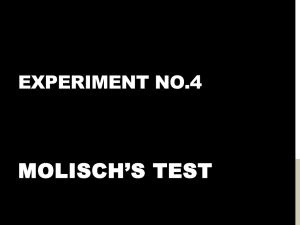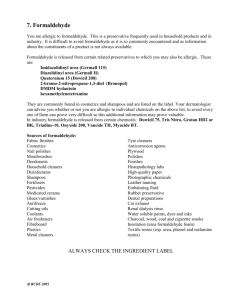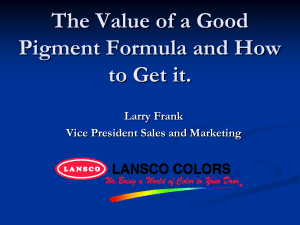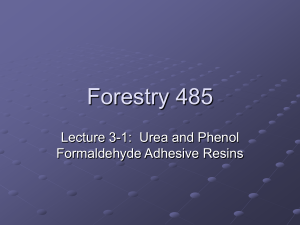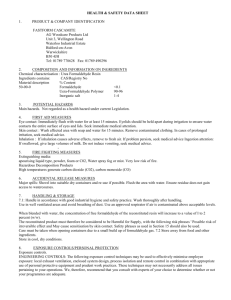Document 10288351
advertisement
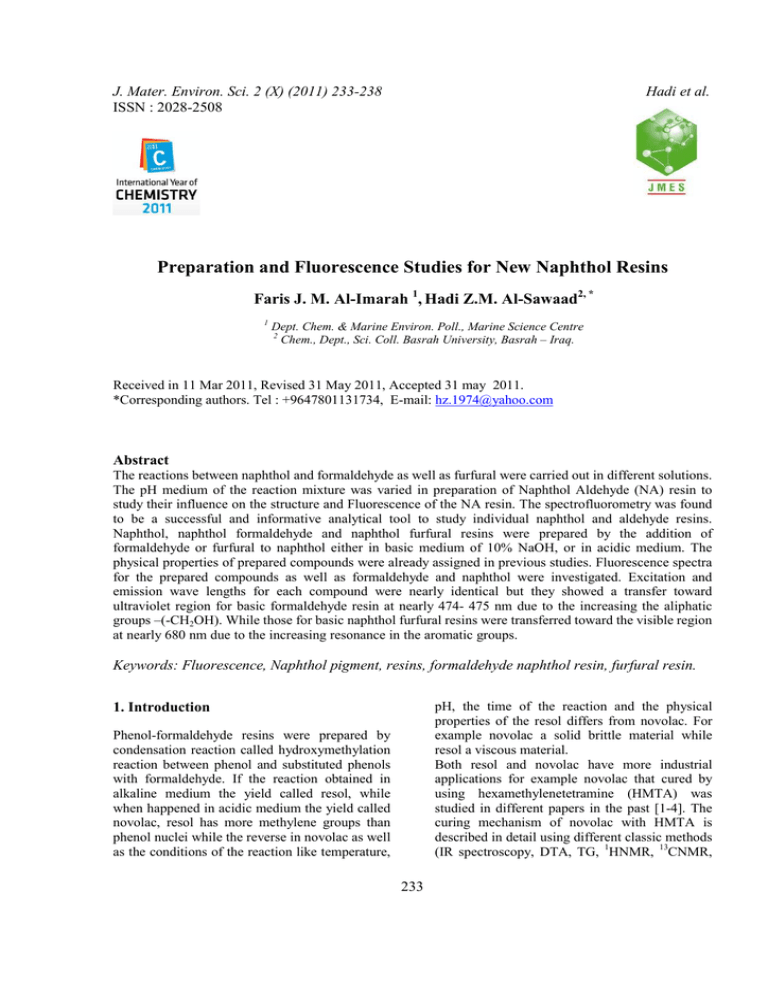
J. Mater. Environ. Sci. 2 (X) (2011) 233-238 ISSN : 2028-2508 Hadi et al. Preparation and Fluorescence Studies for New Naphthol Resins Faris J. M. Al-Imarah 1, Hadi Z.M. Al-Sawaad2, * 1 Dept. Chem. & Marine Environ. Poll., Marine Science Centre 2 Chem., Dept., Sci. Coll. Basrah University, Basrah – Iraq. Received in 11 Mar 2011, Revised 31 May 2011, Accepted 31 may 2011. *Corresponding authors. Tel : +9647801131734, E-mail: hz.1974@yahoo.com Abstract The reactions between naphthol and formaldehyde as well as furfural were carried out in different solutions. The pH medium of the reaction mixture was varied in preparation of Naphthol Aldehyde (NA) resin to study their influence on the structure and Fluorescence of the NA resin. The spectrofluorometry was found to be a successful and informative analytical tool to study individual naphthol and aldehyde resins. Naphthol, naphthol formaldehyde and naphthol furfural resins were prepared by the addition of formaldehyde or furfural to naphthol either in basic medium of 10% NaOH, or in acidic medium. The physical properties of prepared compounds were already assigned in previous studies. Fluorescence spectra for the prepared compounds as well as formaldehyde and naphthol were investigated. Excitation and emission wave lengths for each compound were nearly identical but they showed a transfer toward ultraviolet region for basic formaldehyde resin at nearly 474- 475 nm due to the increasing the aliphatic groups –(-CH2OH). While those for basic naphthol furfural resins were transferred toward the visible region at nearly 680 nm due to the increasing resonance in the aromatic groups. Keywords: Fluorescence, Naphthol pigment, resins, formaldehyde naphthol resin, furfural resin. pH, the time of the reaction and the physical properties of the resol differs from novolac. For example novolac a solid brittle material while resol a viscous material. Both resol and novolac have more industrial applications for example novolac that cured by using hexamethylenetetramine (HMTA) was studied in different papers in the past [1-4]. The curing mechanism of novolac with HMTA is described in detail using different classic methods (IR spectroscopy, DTA, TG, 1HNMR, 13CNMR, 1. Introduction Phenol-formaldehyde resins were prepared by condensation reaction called hydroxymethylation reaction between phenol and substituted phenols with formaldehyde. If the reaction obtained in alkaline medium the yield called resol, while when happened in acidic medium the yield called novolac, resol has more methylene groups than phenol nuclei while the reverse in novolac as well as the conditions of the reaction like temperature, 233 J. Mater. Environ. Sci. 2 (X) (2011) 233-238 ISSN : 2028-2508 Hadi et al. GPC, etc), measurements [5-7], the studying of cross linked product of novolac with HMTA at ambient temperature and pH was studied [8]. Resol novolac was prepared and studied as ablative material [9]. The relatively inexpensive and highly versatile family of phenolic resins has played a vital role in construction, automotive, electrical and appliance industries [10]. Different PF resins could be synthesized by using different molar ratios as well as different reactants [11]. The characterization of the resulting products is effected by different temperature and pH. Depending on pH, novolacs were prepared in an acidic pH region whereas resoles were prepared in alkaline reaction as well as in excess mole ratio of formaldehyde to phenol (1<f/p<3) [11]. Phenols resins are polymers used in a wide variety of applications in different areas as the construction, electronic… etc. Some common uses are adhesives, coating, molding, laminate or plastic manufacturing. Phenolic resins are obtained by the condensation of phenol and an aldehyde, commonly formaldehyde, in a batch reactor, in acid or basic media, followed by vacuum distillation to give phenolic products [12]. The synthesis of phenol-formaldehyde resin was carried out at pH 4.0-4.3, formaldehyde to phenol (F/P) of 0.881 in the presence of acid catalyst (hydrochloric acid and oxalic acid), at operating temperature and pressure of 115°C and 1 atmospheric pressure respectively. Forty-six grams of the resin produced was formulated into moulding powder [13]. In this paper an attempt was driven to prepare certain naphthol-aldehyde resins to study their spectroscopic properties such as IR and Fluorescence. 2. Experimental Basic naphthol-aldehyde resin Three necks vessel charged by (1) g naphthol with (80) mL of NaOH solution to get pH=11 medium, (0.83) g furfural (0.08) g in case of formaldehyde) was added to the mixture, the solutions were mixed by mechanical stirrer for 3 hours at 60 ° C, the product was kept to cool and the solution was neutralized by adding 5% H3PO4 solution, filtered by filter paper then the resin is extracted by methanol, finely it characterized by spectroscopic methods. Acidic naphthol-aldehyde resin (0.26)gm furfural (1 ml formaline solution 37%) was dissolved in 20 ml acetic acid using 100 ml volume beaker, 1 gm naphthol was added to the above mixture, heated for 30 min at 100 ° C with stirring by glass rod, solid brittle resin is obtained, then it characterized by spectroscopic methods. 3. Results and discussions The resonance structures of α-naphthol benzien as shown in scheme 1are [1]: OH HO HO C C O mp =121-125 °C; fw = 374.44. Scheme 1: the structure of Naphthol pigment. The characterization of the above compound by FTIR technique as in Figure 1 refers to the broad band stretching from 3000 to 3250 cm -1 is due to the OH group from naphthol hydroxide (methylol group), the presence of strong band is due to the aromatic (C=C) at 1650 cm -1, and weak band at 2850 cm -1 due to aromatic stretching for (-CH) group [14]. 234 J. Mater. Environ. Sci. 2 (X) (2011) 233-238 ISSN : 2028-2508 Hadi et al. The product 1 that shown in scheme 2 yields by reaction between naphthol with formaline solution 37% (formaldehyde) in basic medium. HO OH CH2 CH2 OH C OH Scheme 2: the structure of substituted methylol Naphthol pigment. Figure 1. IR spectrum for alpha-naphthol pigment. The comparison between IR spectrum for Naphthol pigment in Figure 1 and IR spectrum for methylol pigment in Figure 2 explained that presence of doublet band in Figure 2 at 1350 cm -1 belong to the methylol group(-CH2OH) [15], asymmetric and symmetric stretching vibration that belong to aliphatic (-CH2) group. While the product 2 yield by reaction between naphthol with furfural in basic medium as shown in scheme 3. 235 J. Mater. Environ. Sci. 2 (X) (2011) 233-238 ISSN : 2028-2508 Hadi et al. OH OH HC O O CH OH C OH Scheme 3: the structure of substituted furfurylol Naphthol pigment. Figure 2. IR spectrum for methylol alpha-naphthol pigment. The characterization of the above product can be shown in Figure 3: 236 J. Mater. Environ. Sci. 2 (X) (2011) 233-238 ISSN : 2028-2508 Hadi et al. Figure 3. IR spectrum for bis-hydroxy methylene furfural alpha-naphthol pigment. (furanyl group) , the bands in 1600-1650 cm -1 insist that presence of the aromatic (C=C) for phenyl and furanyl groups respectively [silverstien]. The product 1 if condensed yields as in scheme 4: In Figure 3 the stretching frequency can be explained as weak band in 3100 cm -1 for (-CH) aromatic group, no aliphatic (-CH) group compared with methylol naphthol pigment, also presence of sharp band at 1050 cm -1 insist that aromatic (C-O) belong to aromatic ether group O O O CH2 CH2 CH2 CH2 OH HO OH C OH HO C OH Scheme 4: the structure of condensed methylol Naphthol pigment. The product 2 if condensed yields as in scheme 5: O O O O HC CH C CH HC OH HO O O O OH OH HO C OH Scheme 5: the structure of condensed furfurylol Naphthol pigment. On the other hand, the fluorescence spectrometry was utilized to monitor the condensation reaction. The spectra of naphthol and aldehyde solutions as well as their basic resins are shown in Figure 4 and the assigned excitation and emission spectra are collected in Table 1. 237 J. Mater. Environ. Sci. 2 (X) (2011) 233-238 ISSN : 2028-2508 Hadi et al. Table 1: Assigned excitation and emission spectra for the new resins and starting materials. No. compound Medium λexcitation (nm) λemission (nm) 1 37% formaline - 549 550 2 naphthol - 385 386 3 Naphtho-formaldehyde Basic 474 475 4 Naphthol-furfural Basic 680 680 1 4 3 2 300 Figure 4. Fluorescence spectra for 1) Formaldehyde pigment, 2) Naphthole pigment, 3) FormaldehydNaphthol in basic medium and 4) Furfural- Naphthol in basic medium. Some of authors tried to react different aldehydes with phenol or substituted phenols to get the phenolic resins in the presence of an acidic or basic catalyst, phenolic resins used as adhesives, coating, and molding compounds, the type of catalyst used, the ratio of reactants, and the reaction condition determine the molecular structure and physical properties of the resin product [16]. The pH value of the reaction mixture was varied to study their influence on the structure of NF resin. An ATR-FTIR spectrometry was found to be a successful and informative analytical tool for determining individual phenol and formaldehyde 238 J. Mater. Environ. Sci. 2 (X) (2011) 233-238 ISSN : 2028-2508 Hadi et al. conversions and prepolymer composition changes as a function of time when the condensation reaction was carried out [16-18]. Compounds with poly-substituted phenols were used to prepare methylol of those compounds by reaction of the specified phenol rings with formaldehyde in alkaline medium, the methylol groups (-CH2OH) get compounds higher activity than the original compound only and the last used to prepared unsaturated ester and amino and ether of the original compound [15,19-20]. The resonance in Figure 1 for the naphthol pigment can be applied on the product 1 and 2, and it should be explained that preparation product 1 and 2 should be found the red shift in wave length of the absorbance for the mentioned products due to presence the new chromophor (CH2OH) groups in product 1 and groups in product2. Thus in Table 1, the fluorescence study explained that, preparation of naphthol formaldehyde resin explained red shift in both λexcitation from 385 in naphthol pigment to 474 nm in naphthol formaldehyde resin ( red shift by 89 nm) and λemission from 386 in naphthol pigment to 475 nm naphthol formaldehyde resin (red shift by 89 nm) represent transfer of the absorbance from UV to visible region, it is obvious when naphthol furfural resin compared with naphthol pigment by red shift in both λexcitation and λemission by 295 nm as shown in Table 1. Hence, naphthol furfural resin has sharp band with relative intensity nearly 44% as in band 4, no large difference in relative intensity for band 2 and 3 (about 38% and 39% respectively) for naphthol and naphthol formaldehyde respectively but little sharp compared with the band 4, the fluorescence spectra can be shown in Figure 4. furfural resins due to the insertion of new chromospheres i.e., (-CH2OH) groups in product 1 and product 2 respectively. groups in 3. The red shift in product 2 more than product 1due to presence of aromatic rings more than in the naphthol pigment and product 1 make it absorb near visible region compared with product 1. References 1. Orrell, E.W, Burns, R, Plastic & Polymers, 2 (1968) 469. 2. Kopf, P.W., Wagner, E.R, J. Polym. Chem. Ed., 11, 1973, 939. 3. Knop, A., Scheib, W., Chem and Appl. of Phenolic resins, Springer- Verlag Berlin, Heidelberg, 1985, 34-53. 4. Sojka, S.A, Wolfe, R.A, Dietz, E.A, and Dannels, B.F, Macromolecules, 12(4), 1979, 767. 5. Caulfield, M.J, and Solomon, D.H, Polymer, 40, 1999, 3041. 6. Gorbachev, G.S, et al., Plasticheskie massi, 8, 1987, 6 (In Russian). 7. Sojka, S.A, Wolfe, R.A, Dietz, E.A, Gunther, G.D, Macromolecules, 14, 1981, 1539. 8. Iliev, I, Yordanova, H, Petrenko, P, Novakov, P, J. Univ. Chem. Techn. Metall. 41(1), 2006, 29-34. 9. Najm, T.S, Naji, A.M and Burbooti, M.M, Leonardo electronic,J. of practis and tech p34-46, 1583, 2008. 10. Knop, A., Pilato, L.A, Phenolic resins, Springer –Berlag, Berlin, 1985. 11. Poljansek, I, Krajanc, M, Acta Chim. Slov., 2005, 52:238-244. 12. Urti, A, Gutierrez, R and Ortiz, I, Desalination, 2009, 245:444-450. 13. S. Kumar, H, Tripathi, K.S, Bajpai, G., E-J. Chem., 2009, 6(4):1253-1259. Conclusion The conclusions can be summarized as bellow: 1. Both IR and fluorescence spectra for naphthol, naphthol formaldehyde and naphthol furfural resins insist that the last compounds were prepared. 2. Red shift in the absorbance of the naphthol pigment compared with naphthol formaldehyde and naphthol 239 J. Mater. Environ. Sci. 2 (X) (2011) 233-238 ISSN : 2028-2508 Hadi et al. 14. R.M. Silverstein, R.M. Webster, D.J. Kiemle, 7th ed, John Wiely and Sons, Inc,p 102, 2005. 15. AL-Sawaad, H.Z, M.Sc. thesis, Univ. of Basrah, College of Science, 2001. 16. Osemeahon, A, Barminas, S.A, J. T., Int. J. Phys.Sci. 2007, 2(7):169-177. 17. Kirk-Othmer,"Encyclopedia of chemical technology, phenolic resins, 1996, 603644. 18. Myres, G.E, Christiansen, A.W, Geimer, R.L., Follensbee, R.A., Koutsky, J.A, J. of Appl. Polym. Sci. vol 43,237-250, 1991. 19. Najm, T.S, Naji, A.M, Burbooti, M.M,, Leonardo electronic, J. Practis and Tech p34-46, 1583, 2008. 20. Kumar, H., Tripathi, S.K, Mistry, S., Bajpai, G., E-J. chem. 6(4) (2009) 12531259. (2011) http://www.jmaterenvironsci.com 240
